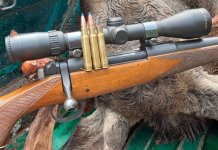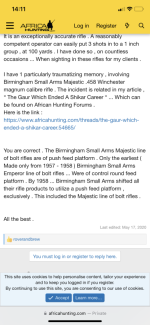Backcountryal
CGN Regular
- Location
- New Zealand
BSA MA Viscount, often referred to as a "Hunter", manufactured 1956 - 63. They marketed some as the Featherweight, and had the action scalloped out to reduce weight, yours appears to be a featherweight. Great rifles, and that one looks all original. The integral brake was called a BESA brake, was often cut off and recrowned. Also came with a spring metal "clip' thingy on the barrel and you could slip it over the brake if you didnt like it, or slip it back if you felt you needed some diminished recoil. Controlled feeding means you should only feed rounds in to the chamber from the mag to allow the cartridge rim to slip in to the extractor. Not a good idea to throw a round on to the mag and try to feed it like a push feed, will sometimes snap or bend the extractor.
As said above, the trigger is excellent and fully adjustable. But best to consult with a good old school gunsmith cos they are a tad complicated. I have a full schematic and instructions for the trigger here that I can send if you need it.
The stocks are excellent and strong, no need to change them. Should you actually break one, Boyds use to make one to fit the Herters U9 and they are a simple fit.
If you need some genuine rings of that era, I may have a set of genuine PH rings here that fit. Happy to post them to you.
As said above, the trigger is excellent and fully adjustable. But best to consult with a good old school gunsmith cos they are a tad complicated. I have a full schematic and instructions for the trigger here that I can send if you need it.
The stocks are excellent and strong, no need to change them. Should you actually break one, Boyds use to make one to fit the Herters U9 and they are a simple fit.
If you need some genuine rings of that era, I may have a set of genuine PH rings here that fit. Happy to post them to you.








































































